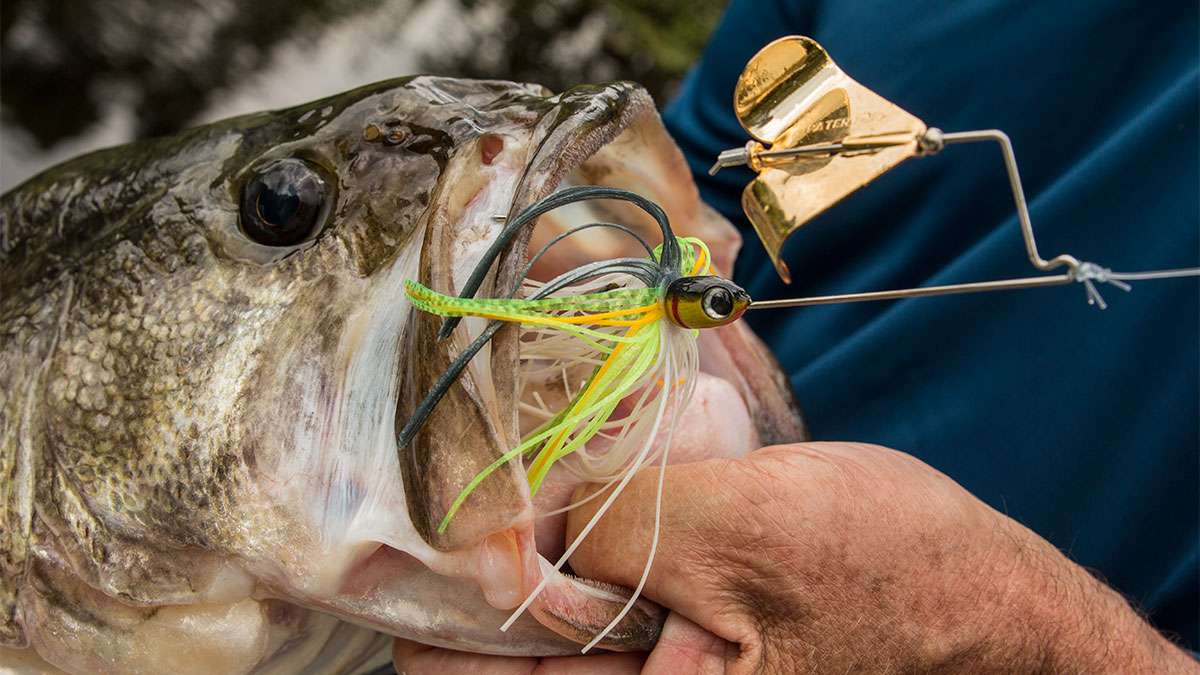
In part 1 of this series, we talked about different types of topwater plugs. We also discussed the various situations where one might outperform another. Included in that discussion were poppers, walkers and prop baits.
To expand on our range of topwater lures, this time we’ll focus on buzzbaits and the situations where they might prove most effective.
First, it’s important to separate the various styles of buzzbaits that are out there. Among them are “squealers,” “clackers” and inline models. Each has its own unique attributes, and any can be the right choice in a given situation. So let’s break them down.
Squeaky Wheel Gets The…
Squealers (also referred to as “squeakers”) are so named because of the high-pitched sounds created from friction caused when the rotating blade(s) rub against a securing rivet. It’s a sound that can drive bass crazy.
There are a lot of different makes out there, but it’s hard to go wrong with the Original Lunker Lure. It’s been catching fish for decades and still works well today. My personal preference, though, is for one I designed for Hildebrandt called the “SqueakEasy.” Its tin construction allows it to stay on the surface at ultra-slow speeds, which can really pay off when fish are reluctant to chase or even bite.
I like squealers anytime conditions are calm and quiet. They provide a more subtle presentation … an almost stealthy approach. And that’s often required when things are too still and the baitfish aren’t moving.
I target sparser cover, like scattered stumps, rock, grass clumps or isolated laydowns — places that might hold solitary, resident bass. This doesn’t mean they won’t work around thicker cover, like docks, cypress thickets or grassbeds. They can work there, too. It’s just that they frequently outperform other types of buzzers in thinner cover, especially when the conditions are calm.
The presentation is simple: Cast past or as close to the target as the situation will allow, then begin the retrieve as soon as the lure touches down. That’s critical for any type of buzzbait, as many strikes will result in the first turn of the reel handle.
Generally speaking, a slow to medium retrieve works best. Again, these are the more subtle of the buzzbait types and therein lies their advantage.
Clickety Clack…
When skies are low and the winds are blustery, that’s when I break out a clacker-style buzzer. They’re the true noise makers, the agitators. They can provoke fish that might otherwise pass on an offering. They also have the ability to call fish from great distances and from thicker cover.
There are many makes out there, but my favorite is the Hildebrandt “HeadBanger.” It puts out a super loud clacking sound … almost like a string of tin cans dragging behind a newlywed’s car.

It’s my favorite bait for large, expansive grassbeds — either submerged or emergent — regardless of their depth. In fact, I’ve caught some really big bass from dense hydrilla and milfoil, in as much as 10 feet of water. And when a bass comes that far, the strike is usually explosive.
I also like clacker-style buzzers around cypress trees, buckbrush, flooded terrestrial grass or in thick stumpfields. The retrieve is brisk and aggressive. In fact, I often race the bait by these targets. And I’ll often make repeated casts to high percentage areas.
Repeated casts are a great way to provoke stubborn fish. But be sure to change your angle of attack. That can sometimes make all the difference.
Inline Outline
One of the oldest, yet most overlooked buzzer types are inline models — such as the Gold Wing, Floyd’s and Uncle Buck’s Buzzers. At one time, these were a mainstay among topwater enthusiasts. But because of changing trends, they’re apparently no longer in vogue.
That’s unfortunate because inline buzzbaits can go where other topwaters can’t. So long as there is a slight film of water on the surface, the blade of an inline buzzer will continue to spin and attract fish. And because they feature a large weedguard, they can pass through all types of snags, like the branches of laydown trees and flooded brush or through thick lily pads fields.
They’re the ATVs of buzzbaits!
Fishing them is simple, too. Just cast them anywhere you believe a fish might be holding and run the lure over its head. The retrieve is usually medium to brisk. And like the clacker, repeated casts can oftentimes prove productive.
Buzzbait Wrap-Up
It’s important to carry at least two sizes in each style of buzzbait you choose — such as 1/4- and 1/2-ounce. There will be times when a smaller profile or one that emits less sound will be the better choice. On other occasions, a bigger bait that puts out more sound will be best. Determining which may be a process of elimination.
Same with color. Although I carry a fairly narrow selection, it does include a range of blade and skirt variations. For blades, I like black, gold and silver. For skirts, black, white or white with chartreuse accents.
I go with darker combinations on dark days, like gold and black or black on black. On bright days, or when I know the bass are keyed on baitfish, I’ll go with silver and white or gold and white with chartreuse accents. Other colors can also work, but these are my basic selections.
So now that I’ve shared all this information, I hope you’ll take full advantage and apply it next time you’re on the water. Topwater season is here and I can’t think of a better way to enjoy bass fishing.

